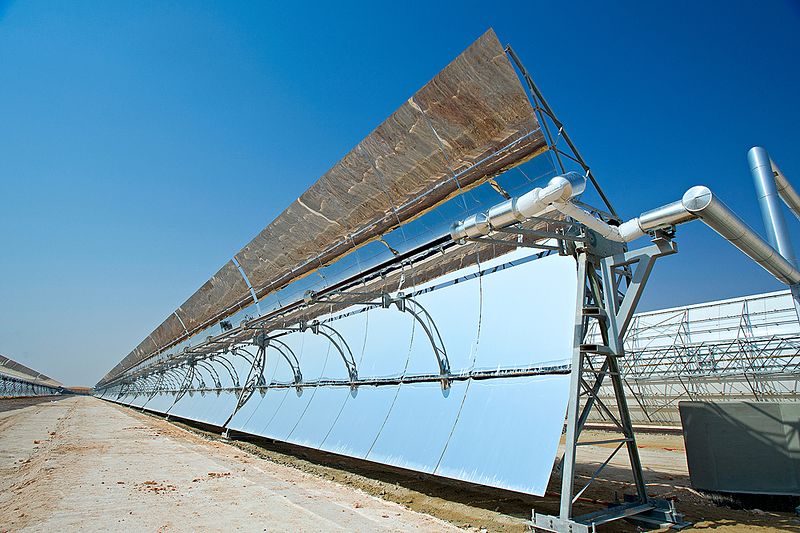
The Shams 1 solar power station in Abu Dhabi uses parabolic troughs and has a capacity of 100 megawatts [Photo: Masdar]
The Middle East may be home to some of the world’s largest oil reserves, but some countries in the region are striving to make headway in a very different field: renewable energy.
Morocco and Dubai have already made headlines for building two of the world’s largest solar energy farms. In June this year, a consortium based in the United Arab Emirates set a world record when it bid to develop Dubai’s Mohammad Bin Rashid al-Maktoum solar park for just 2.99 cents per kilowatt hour. (By comparison, the lowest bids in the US have been between 3.5-4 cents per kilowatt hour.)
Three months later, a Chinese-Japanese consortium brought the threshold down further by bidding 2.42 cents per kilowatt hour on an unsubsidized solar project in neighboring Abu Dhabi. These very low bids could be a sign that solar projects in the region are becoming more economical, although it remains to be seen whether the projects will be profitable.
A more telling shift came from Saudi Arabia, where earlier this year oil giant Saudi Aramco partnered with General Electric to install the kingdom’s first wind turbine, in the country’s northwest. The development marked Saudi Arabia’s renewed commitment to its “Vision 2030,” which aims to generate 9.5 gigawatts of renewable energy by 2030.
This comes on the heels of ambitious Saudi pronouncements made last year during the landmark Paris climate conference. During the conference, the Saudi oil minister reiterated the kingdom’s plan to become a “global power” in solar and wind energy. Given that Saudi Arabia has one of the highest solar irradiance rates on earth, this lofty goal is certainly within its grasp.
Lately, Qatar, which has the highest per capita greenhouse gas emissions in the world, announced that 20% of its energy demand by 2030 would be met by solar energy. The investments in renewables have been growing at a healthy pace in the region, tripling in 2015 alone.
For the fossil fuel-rich Gulf states, climate change is likely not the prime motivation for this drive towards renewables. More pressing reasons include the low price of oil, which has been causing huge budget deficits in oil-exporting countries, and the tense geopolitical situation in the region. The Gulf states’ oil revenues have further shrunk due to an increase in demand caused by high population growth rates. The resulting financial crunch is pushing some to call for reducing dependency on oil, and diversifying their economies.
Meanwhile, countries like Morocco, which does not have any major oil or gas reserves and imports 97% of its energy supply, sees expanding renewable energy supply as a way to promote sustainable national development. In fact, Morocco is making a concerted effort to become a regional powerhouse for renewable energy. Overall, the Middle East and North Africa (MENA) is expected to invest around $670 billion in renewable energy over the next 25 years.
To achieve their green energy targets, MENA countries will likely have to focus on four areas. First, they need to cut their subsidies for fossil fuels to promote renewables. Second, they need to switch from conventional power grids to “smart grids,” which allow digital communication between consumers and utilities, to improve energy efficiency in the face of high demand growth. Smart grids also enable the power grid to integrate electricity from multiple sources, including renewables.
Third, more public and private-sector investment in research is required to address region-specific problems with using renewable energy, such as the accumulation of dust and grime on PV solar panels. Dust collection prevents sunlight from reaching the solar panels, reducing their efficiency by about 10% in the absence of a cleaning mechanism.
Similarly, sandblasting during desert storms can dramatically reduce the life of panels. Robot cleaners provide one effective way to address the issue, but this is quite expensive at the moment. Most of the technological development on this front has been in the methods used to clean dusty panels; however, more innovation is required to prevent sand from accumulating on panels in the first place. Finally, media, universities and other educational centers need to be more proactive to ensure public awareness, especially among youth.
Most of all, though, regional stability is needed for these initiatives to bear fruit. High political risk leads to higher investment costs, making the switch to green energy all the more difficult. For now, however, the prospects for renewables in the region look encouraging.
